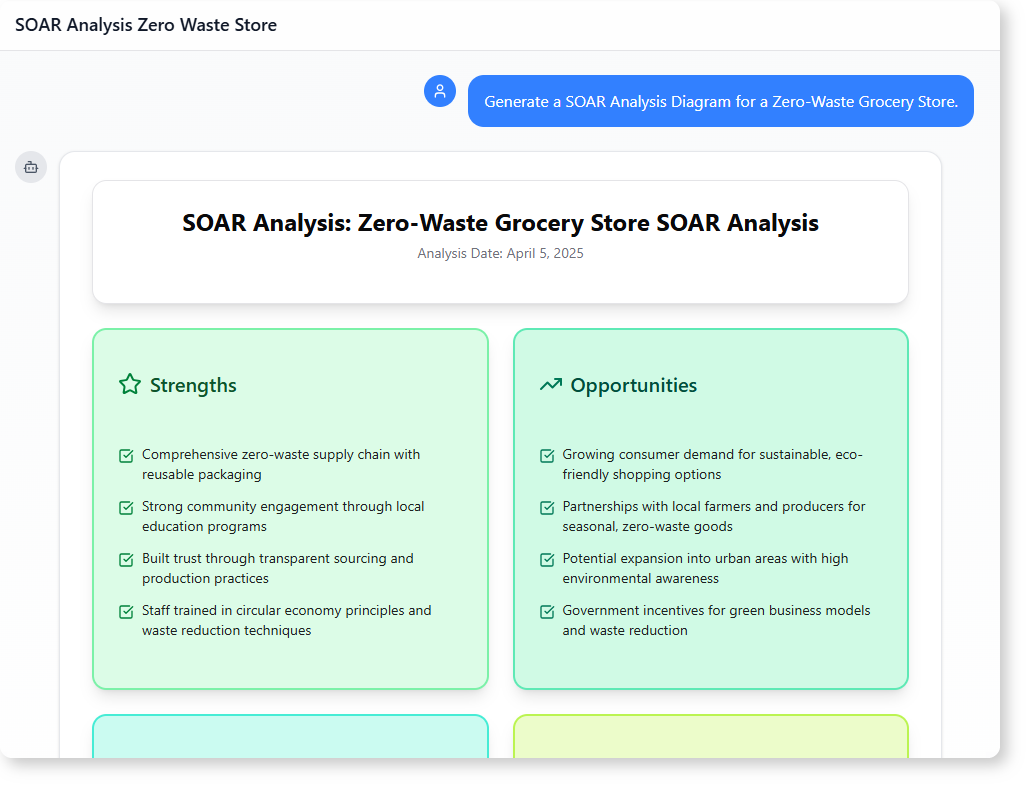Now Reading: How AI-Powered Modeling Software Builds a Zero-Waste Grocery Store Strategy
-
01
How AI-Powered Modeling Software Builds a Zero-Waste Grocery Store Strategy
How AI-Powered Modeling Software Builds a Zero-Waste Grocery Store Strategy
How AI-Powered Modeling Software Builds a Zero-Waste Grocery Store Strategy
Imagine a grocery store that doesn’t just sell produce—it educates, reduces waste, and builds community trust. This isn’t a distant dream. It’s a reality being shaped by modern businesses using AI-powered modeling software.
A local store owner wanted to understand the foundation of their sustainability efforts. They didn’t need a team of analysts or months of manual reviews. Instead, they used an AI-powered modeling tool to generate a SOAR analysis for a zero-waste grocery store. The result? A clear, actionable roadmap with strengths, opportunities, and long-term ambitions.
This isn’t just about diagrams. It’s about turning vague ideas into structured strategies with real-world impact.

Why a SOAR Analysis Matters for Sustainability
A SOAR analysis—short for Strengths, Opportunities, Aspirations, and Results—is a powerful way to assess any organization’s current state and future potential. In sustainability, it helps turn environmental goals into measurable actions.
For a zero-waste grocery store, the SOAR framework gives clarity:
- What’s already working?
- Where can growth happen?
- What does the future look like?
- How will success be measured?
Without this structure, conversations about sustainability can feel scattered. With AI-powered modeling software, the process becomes immediate, intuitive, and deeply insightful.
The Journey: From Prompt to Strategy
The owner started with a simple question: “How can I plan a zero-waste grocery store using a SOAR analysis?”
They didn’t need to know the software’s name. They just needed to guide the AI to generate a meaningful diagram.
Step 1: Request the SOAR Diagram
The first prompt was straightforward:
“Generate a SOAR Analysis Diagram for a Zero-Waste Grocery Store.”
The AI interpreted the request and created a visual model that mapped out the store’s current state and future vision. It didn’t guess. It structured the data around real-world business principles.
The resulting diagram clearly separated the four elements:
- Strengths – What the store already does well
- Opportunities – Areas where growth or change could happen
- Aspirations – Long-term goals for the business
- Results – Measurable outcomes tied to each point
Step 2: Extract Key Insights
Next, the owner asked:
“Summarize the key findings from this SOAR Analysis Diagram in a way that highlights opportunities for improvement.”
The AI didn’t just repeat the data. It interpreted it, grouped similar themes, and presented actionable insights. For instance:
- The store’s use of reusable packaging is a strength, but customer habits need support.
- Growing demand for sustainable shopping presents a chance to expand product lines.
- Partnerships with local farms could improve supply chain resilience.
- Government incentives can be leveraged to reduce startup costs.
This wasn’t just a list. It was a strategy in motion.
What the AI-Powered Modeling Software Delivered
The tool didn’t just draw a diagram. It provided a structured, human-readable breakdown that a business leader can act on.
The output wasn’t theoretical. It was grounded:
- Strengths highlighted proven practices: reusable packaging, community education, transparent sourcing.
- Opportunities pointed to growth levers: consumer demand, local partnerships, expansion into urban areas.
- Aspirations set bold, realistic targets: zero single-use plastics by 2030, 100% carbon-neutral operations by 2027.
- Results gave clear metrics: 90% waste reduction in 18 months, 95% customer satisfaction in 12 months.
This level of clarity is hard to achieve manually. With AI-powered modeling software, the user gets a focused, reliable, and intelligent view of their business potential.
Why This Tool Stands Out
Not every AI modeling tool is built for real-world business decisions. This one is designed to understand context.
It doesn’t rely on templates or rigid formats. Instead, it listens to the user’s intent and responds with relevant, structured insights.
For a zero-waste grocery store, this means:
- No need to spend hours on spreadsheets
- No guesswork in identifying what’s working
- Clear pathways for improvement
It’s not magic. It’s intelligent modeling made accessible.
Real-World Impact Through AI Modeling
This isn’t a theoretical exercise. It’s a practical tool used by people making real decisions.
The owner of the store used the SOAR analysis to:
- Rebalance staff training focus
- Plan community events around seasonal produce
- Identify which local farms to partner with
- Build a customer loyalty program based on sustainability
Each action came from a clear, structured insight—something only an AI-powered modeling tool could deliver efficiently.
Frequently Asked Questions
What is the role of AI in creating a SOAR analysis?
AI helps structure complex business ideas into a clear, visual format. It identifies key themes and organizes them into strengths, opportunities, aspirations, and results. This makes it easier for leaders to see patterns and make decisions.
Can AI-powered modeling software be used for any sustainability initiative?
Yes. The same framework applies to recycling centers, green buildings, or zero-waste events. The tool adapts based on the context and user input.
Is the SOAR analysis tool suitable for small businesses?
Absolutely. The clarity and simplicity of the SOAR format make it ideal for small teams without deep analytical experience. AI-powered modeling software removes the barrier to entry.
What makes Visual Paradigm different from other AI modeling tools?
Visual Paradigm focuses on real-world business use cases. Its AI-powered modeling software is trained to understand domain-specific contexts—like sustainability, supply chains, and community engagement—so the outputs are relevant, not generic.
Ready to map out your system’s interactions? Give our AI-powered modeling software a try at Visual Paradigm’s AI Chatbot today!.
